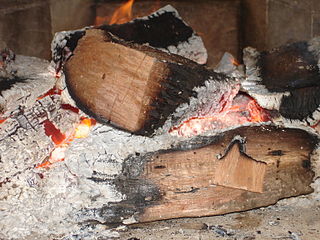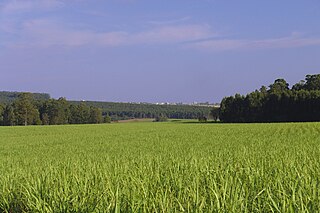
The pyrolysis process is the thermal decomposition of materials at elevated temperatures, often in an inert atmosphere.
Climate engineering is a term used for both carbon dioxide removal and solar radiation management, also called solar geoengineering, when applied at a planetary scale. However, they have very different geophysical characteristics which is why the Intergovernmental Panel on Climate Change no longer uses this overarching term. Carbon dioxide removal approaches are part of climate change mitigation. Solar geoengineering involves reflecting some sunlight back to space. All forms of geoengineering are not a standalone solution to climate change, but need to be coupled with other forms of climate change mitigation. Another approach to geoengineering is to increase the Earth's thermal emittance through passive radiative cooling.

Bioenergy is energy made or generated from biomass, which consists of recently living organisms, mainly plants. Types of biomass commonly used for bioenergy include wood, food crops such as corn, energy crops and waste from forests, yards, or farms. The IPCC defines bioenergy as a renewable form of energy. Bioenergy can either mitigate or increase greenhouse gas emissions. There is also agreement that local environmental impacts can be problematic.

Climate change mitigation is action to limit climate change. This action either reduces emissions of greenhouse gases or removes those gases from the atmosphere. The recent rise in global temperature is mostly due to emissions from burning fossil fuels such as coal, oil, and natural gas. There are various ways that mitigation can reduce emissions. These are transitioning to sustainable energy sources, conserving energy, and increasing efficiency. It is possible to remove carbon dioxide from the atmosphere. This can be done by enlarging forests, restoring wetlands and using other natural and technical processes. The name for these processes is carbon sequestration. Governments and companies have pledged to reduce emissions to prevent dangerous climate change. These pledges are in line with international negotiations to limit warming.

Carbon capture and storage (CCS) is a process in which a relatively pure stream of carbon dioxide (CO2) from industrial sources is separated, treated and transported to a long-term storage location. For example, the carbon dioxide stream that is to be captured can result from burning fossil fuels or biomass. Usually the CO2 is captured from large point sources, such as a chemical plant or biomass plant, and then stored in an underground geological formation. The aim is to reduce greenhouse gas emissions and thus mitigate climate change. The IPCC's most recent report on mitigating climate change describes CCS retrofits for existing power plants as one of the ways to limit emissions from the electricity sector and meet Paris Agreement goals.

Carbon sequestration is the process of storing carbon in a carbon pool. Carbon sequestration is a naturally occurring process but it can also be enhanced or achieved with technology, for example within carbon capture and storage projects. There are two main types of carbon sequestration: geologic and biologic.
Pyrolysis oil, sometimes also known as bio-crude or bio-oil, is a synthetic fuel with limited industrial application and under investigation as substitute for petroleum. It is obtained by heating dried biomass without oxygen in a reactor at a temperature of about 500 °C (900 °F) with subsequent cooling, separation from the aqueous phase and other processes. Pyrolysis oil is a kind of tar and normally contains levels of oxygen too high to be considered a pure hydrocarbon. This high oxygen content results in non-volatility, corrosiveness, partial miscibility with fossil fuels, thermal instability, and a tendency to polymerize when exposed to air. As such, it is distinctly different from petroleum products. Removing oxygen from bio-oil or nitrogen from algal bio-oil is known as upgrading.

Biochar is the lightweight black residue, made of carbon and ashes, remaining after the pyrolysis of biomass, and is a form of charcoal. Biochar is defined by the International Biochar Initiative as "the solid material obtained from the thermochemical conversion of biomass in an oxygen-limited environment". Biochar is a stable solid that is rich in pyrogenic carbon and can endure in soil for thousands of years.

Biomass, in the context of energy production, is matter from recently living organisms which is used for bioenergy production. Examples include wood, wood residues, energy crops, agricultural residues including straw, and organic waste from industry and households. Wood and wood residues is the largest biomass energy source today. Wood can be used as a fuel directly or processed into pellet fuel or other forms of fuels. Other plants can also be used as fuel, for instance maize, switchgrass, miscanthus and bamboo. The main waste feedstocks are wood waste, agricultural waste, municipal solid waste, and manufacturing waste. Upgrading raw biomass to higher grade fuels can be achieved by different methods, broadly classified as thermal, chemical, or biochemical.

The Virgin Earth Challenge was a competition offering a $25 million prize for whoever could demonstrate a commercially viable design which results in the permanent removal of greenhouse gases out of the Earth's atmosphere to contribute materially in global warming avoidance. The prize was conceived by Richard Branson, and was announced in London on 9 February 2007 by Branson and former US Vice President Al Gore.

Slash-and-char is an alternative to slash-and-burn that has a lesser effect on the environment. It is the practice of charring the biomass resulting from the slashing, instead of burning it. Due to incomplete combustion (pyrolysis) the resulting residue matter charcoal can be utilized as biochar to improve the soil fertility.

Carbon dioxide removal (CDR), also known as carbon removal, greenhouse gas removal (GGR) or negative emissions, is a process in which carbon dioxide gas is removed from the atmosphere by deliberate human activities and durably stored in geological, terrestrial, or ocean reservoirs, or in products. In the context of net zero greenhouse gas emissions targets, CDR is increasingly integrated into climate policy, as an element of climate change mitigation strategies. Achieving net zero emissions will require both deep cuts in emissions and the use of CDR, but CDR is not a current climate solution. In the future, CDR may be able to counterbalance emissions that are technically difficult to eliminate, such as some agricultural and industrial emissions.

Bioenergy with carbon capture and storage (BECCS) is the process of extracting bioenergy from biomass and capturing and storing the carbon, thereby removing it from the atmosphere. BECCS can be a "negative emissions technology" (NET). The carbon in the biomass comes from the greenhouse gas carbon dioxide (CO2) which is extracted from the atmosphere by the biomass when it grows. Energy ("bioenergy") is extracted in useful forms (electricity, heat, biofuels, etc.) as the biomass is utilized through combustion, fermentation, pyrolysis or other conversion methods.

Hydrothermal carbonization (HTC) is a chemical process for the conversion of organic compounds to structured carbons. It can be used to make a wide variety of nanostructured carbons, simple production of brown coal substitute, synthesis gas, liquid petroleum precursors and humus from biomass with release of energy. Technically the process imitates, within a few hours, the brown coal formation process which takes place in nature over enormously longer geological time periods of 50,000 to 50 million years. It was investigated by Friedrich Bergius and first described in 1913.
Soil management is the application of operations, practices, and treatments to protect soil and enhance its performance. It includes soil conservation, soil amendment, and optimal soil health. In agriculture, some amount of soil management is needed both in nonorganic and organic types to prevent agricultural land from becoming poorly productive over decades. Organic farming in particular emphasizes optimal soil management, because it uses soil health as the exclusive or nearly exclusive source of its fertilization and pest control.

Blue carbon is a term used in the climate change mitigation context that refers to "biologically driven carbon fluxes and storage in marine systems that are amenable to management." Most commonly, it refers to the role that tidal marshes, mangroves and seagrasses can play in carbon sequestration. Such ecosystems can contribute to climate change mitigation and also to ecosystem-based adaptation. When blue carbon ecosystems are degraded or lost they release carbon back to the atmosphere.
David Alan Laird is a professor at Iowa State University, Department of Agronomy, Ames, Iowa. Throughout his career as a soil scientist, he made many contributions to clay mineralogy, including developing a model describing the relationship between cation selectivity and the extent of crystalline swelling in expanding 2:1 phyllosilicates. Other work demonstrated the effects of ionic strength and cation charge on the breakup and formation of smectitic quasicrystals and the principle of cation demixing which lent great insight into understanding clay flocculation. Investigations in organic matter interactions with clay minerals led to the development of the idea of dual mode bonding in which amphipathic molecules interact with substrates by both hydrophobic-hydrophobic and hydrophilic-hydrophilic interactions. Laird et al. (2008) showed that smectites, a class of clay minerals found in soil, can adsorb tremendous amounts of organic materials and, hence, strongly influence the transport and bioavailability of organic materials including pesticides applied to the soil. In a study published in 2003, Gonzalez and Laird showed that new carbon derived from decomposing plant material tends to preferentially sorb to the fine clay subfraction of soil. Further work demonstrated that the coarse clay fraction had the greatest carbon to nitrogen ratio, greatest minimum residence time in the soil based on 14C radioisotope dating, and contained carbon most recalcitrant to microbial digestion. Collectively many of Dr. Laird's contributions to soil science have provided insight into understanding soil organic matter and clay interactions and, thus, the genesis of soil peds from the molecular viewpoint.

Carbon farming is a name for a variety of agricultural methods aimed at sequestering atmospheric carbon into the soil and in crop roots, wood and leaves. The aim of carbon farming is to increase the rate at which carbon is sequestered into soil and plant material with the goal of creating a net loss of carbon from the atmosphere. Increasing a soil's organic matter content can aid plant growth, increase total carbon content, improve soil water retention capacity and reduce fertilizer use. Carbon farming is one component of climate-smart agriculture.

Carbon capture and utilization (CCU) is the process of capturing carbon dioxide (CO2) from industrial processes and transporting it via pipelines to where one intends to use it in industrial processes.

Kenneth Karl Mikael Möllersten is a Swedish researcher. He holds a PhD in chemical engineering and an MSc in mechanical engineering, both from the Royal Institute of Technology (KTH), Stockholm, Sweden. Möllersten is a consultant and researcher at IVL Swedish Environmental Research Institute, was previously affiliated as a researcher with Mälardalen University and is currently affiliated with KTH.
















